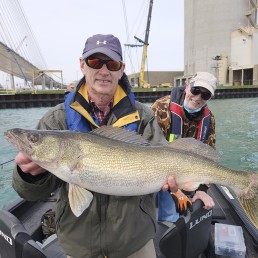Keeping Walleye River Fishing Simple
SHARE THIS POST
Many folks feel that walleyes are hard to catch, and that can be true. They also praise the eating qualities of this fish, and for good reason.
Our group enjoys a good success rate when fishing for walleyes. Yes, we have tough days, but on average, we do better than most. Our philosophy: Keep things simple and fun for all.
Walleyes and rivers go hand-in-hand. In spring, they travel upstream to spawn and then return to the lake they came from. We’re bleed with stable walleye populations in the St. Joe, Kalamazoo, Grand and Muskegon Rivers.
The last Saturday of April is the traditional opener in our area. However, the Detroit and St. Clair Rivers are open all year. If you’ve never fished these two rivers, you need to.
Most anglers vertically jig the big rivers on the east side of the state. Two tips are equally as important.
First, point the trolling motor into the wind. No exceptions. This is the only way that you will be able to keep your line vertical and match the speed of the current at the bottom of the river.
Second, use a size 10 treble stinger hook. You can buy pre-made stinger hooks or make your own; my favorite length is 4 inches. Homemade or store-bought, make sure that the leader is stiff. You want the stinger hook to hold straight back, rather than droop. We like using stinger hooks that are a tad longer than the plastics being used.
Drop your jig down, hit bottom, and then lift up 3 to 6 inches. You always need to know where the bottom is. Let out more line, or reel some in, until your lure barely scratches bottom.
Then, anytime that you don’t feel the bottom, set the hook. When lifting up, if you feel deadness, set the hook.
Are you enjoying this post?
You can be among the first to get the latest info on where to go, what to use and how to use it!
Keep your rod tip close to the water so you can set the hook with more authority. Nearly all jig anglers that I know of today use some type of braided line. Some use 6/2, others 10/4. We use a hi-vis color. You can see your line move easier with hi-vis.
Another great technique that rarely gets a second look on the big rivers is fishing vertically with a Mack’s Smile Blade and a slow death hook. Thread a ‘crawler on the hook up to your knot. Leave 1 inch of crawler daggling behind the hook bend and pinch off the balance.
We like adding a glow bead before the hook, and glow blades on the rig. In early season, we use the .8 blade, and as things heat up, we move to the 1.1 size.
Rivers on the west side of the state are shallower. Early in the season, we enjoy fishing close to Lake Michigan. We start at the mouth of the river and work our way upstream a few miles.
I suggest drifting this rig using a three-way rig. If snagged, you rarely lose more than the sinker. ‘Crawler rigs also work great for trolling downstream. Deep holes and deep runs are best, along with any bridge that you can find. Walleyes are often found just behind a pillar that deflects the current. Watch your graph to see if there is a washed-out depression downstream of the bridge.
Marabou, hair, or bucktail jigs tipped with a minnow can be hands-down best choices in frigid rivers in spring. I also love fishing Northland Whistler Jig heads. On the big deep rivers, we vertical jig with the 1-ounce models (which was recently discontinued. On the shallower rivers on the west side of the state, we either cast and hop in, or we throw it out twenty feet and lift the jig up and let it flutter down. The propeller blade draws the fish in.
If you concentrate on just a few things, your walleye success will go up. Just remember that our local rivers hold some fish all year. These tactics will keep you on walleyes all season. Give ‘em a try.
If you enjoy walleye fishing, you’ll find plenty of helpful walleye fishing insight in every issue of MidWest Outdoors. Subscribe on our website.
MWO
SHARE THIS POST
You may also like...
Nothing found.
Did you enjoy this post?
You can be among the first to get the latest info on where to go, what to use and how to use it!
Jack Payne
Jack Payne is an accomplished angler and hunter who enjoys teaching others as much as learning from others. Seminar speaker, outdoor photography enthusiast, hunter safety instructor and volunteer at many events for both kids and adults as an instructor.
